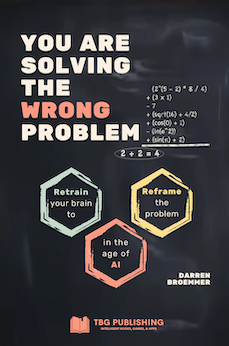From the book "You are Solving the Wrong Problem"Chapter 12: Critical Thinking
"Common sense is not so common." - Voltaire
Critical thinking and problem-solving are two of the most important skills you can learn. This is true in life as well as in your career. Critical thinking alone sets you apart from the majority of the workforce. Studies suggest that critical thinking is a rare skill.
A 2022 Gallup survey found that only 35% of Americans say they are very confident in their critical thinking skills.
Conservatively, I have conducted interviews with over 500 engineering candidates throughout my career, including my five-year tenure at Amazon. During these interviews, my primary goal is to assess how candidates approach and reason through problems. The questions I ask are intentionally challenging, as I only expect exceptional candidates to arrive at complete or near-optimal solutions. Realistically, I do not anticipate that most candidates will fully solve the problems presented. Instead, the evaluation is based on the ability to think critically and methodically about the problem at hand.
Similar to elementary school math classes, candidates are required to "show their work" and demonstrate their thought processes. It is essential for them to exhibit strong critical thinking skills.
At times, critical thinking may seem like common sense. For instance, when reading a well-written piece, it often appears simple and basic. This is because the author has taken the time and effort to break down complex topics and communicate them clearly. Their thoughtful approach enables readers to easily grasp the material. However, it is important to note that the effort involved in writing and editing is significantly greater than the effort required to read and comprehend.
A key takeaway from this book is the importance of using critical thinking to accurately identify the core problem. This does not necessarily require an exceptionally high IQ of 160. Even if you currently lack confidence in your ability, this skill can be developed and honed. The great news is that you can leverage solutions that already exist! You don't have to reinvent the wheel
Finding patterns
Would it surprise you to hear that most problems have already been solved? The expression "standing on the shoulders of giants" metaphorically refers to building upon the knowledge and discoveries of great predecessors to achieve further intellectual advancements. It could be a groundbreaking discovery or theorem, or it could be something really simple that will help you on your journey.
Consider the act of sitting down to solve a Sudoku puzzle. Once you know how to solve one Sudoku, you essentially know how to solve them all. While they may vary in difficulty based on the number of blank squares at the beginning, they all follow a similar pattern. This concept can be applied to other problems as well. If you encounter a problem that appears new to you, ask yourself, what am I truly solving for? Is this a pattern that I have encountered before? Or has someone else already established a pattern for this type of problem?
At its core, many problems have indeed been previously solved. We often mistakenly believe that every problem is unique. However, in reality, there is a vast amount of collective knowledge that precedes us. It is important to recognize that there is a decent likelihood that someone, somewhere has encountered a similar challenge and successfully overcome it. We should not underestimate the power of learning from the experiences of others. By exploring existing solutions, we gain valuable insights. We learn strategies and methodologies that we can adapt and apply to our own circumstances.
It is crucial to not perceive this as cheating. In fact, the ability to determine the right pattern to apply is a critical thinking skill that should be appreciated. It is a prized art that one should be proud of. Pattern recognition drives efficiency and can act as a catalyst for innovation. By combining creative thinking with the application of existing patterns, we can develop new solutions. This interplay forms the essence of effective problem-solving. We can respect the wisdom of the past while actively contributing to the solutions of the future.
The transition of Netflix
As a DVD rental service, Netflix faced a significant challenge in scaling its operations. They experienced issues with managing the growing demand and ensuring fast delivery of DVDs. Moreover, with the rise of the internet, Netflix saw an opportunity to evolve into a streaming service. However, this required handling massive amounts of data and streaming content reliably to millions of users worldwide.
Netflix turned to cloud computing, an established pattern in technology, to address these challenges. They moved their data and services to Amazon Web Services (AWS), one of the leaders in cloud computing. This allowed Netflix to easily scale up or down based on demand. This was crucial for handling peak usage times and expanding to new markets without the need for significant physical infrastructure investments. Using AWS allowed Netflix to convert capital expenditure into operational expenditure, with a pay-as-you-go model. This flexibility was financially beneficial, especially when expanding their user base.
By leveraging a proven pattern, Netflix could focus on their core business, providing great content for everyone in the family. They could focus on content creation, recommendation algorithms, and an improved user experience. These things are what differentiated them in the marketplace.
Applying mathematic concepts and patterns
Fractals are intricate geometric shapes that can be split into parts, each of which is a reduced-scale copy of the whole. This property is known as "self-similarity." Unlike traditional geometric shapes, fractals can exhibit similar patterns at increasingly small scales. They are defined by a recursive or iterative process and are often characterized by their fractal dimension, which exceeds their topological dimension. The following image provides a visual representation of the concept.

This idea, or pattern, turns out to be extremely useful across a number of problem domains. Antenna design uses fractal patterns to fill space efficiently. More wire (or antenna material) can be packed into a smaller area without the elements being too close to each other, which causes interference. The end result is a compact antenna that doesn't sacrifice performance. This is ideal for space-constrained applications like your mobile phone or wearable technology. There are various fractal shapes used in antenna design, like the Mandelbrot set, the Sierpinski triangle, and the Koch curve. Each of these shapes offers different advantages in terms of bandwidth, size, and frequency characteristics.
In the realm of computer graphics and animation, fractals emerged as a groundbreaking tool. Artists and engineers can generate unparalleled realism and detail in virtual landscapes, textures, and special effects. The inherent complexity and self-similar patterns of fractals make them ideally suited for simulating the natural irregularities and intricacies found in real-world environments. Traditional geometric shapes yield overly smooth or uniform representations, whereas fractals can capture the chaotic, yet structured essence of natural elements like mountain terrains, cloud formations, tree branches, and coastlines. A simple conceptual pattern allows graphic designers and animators to generate more lifelike and organic scenes. This enhances the visual richness and immersion of digital worlds.
A large part of critical thinking involves data. The great news is that anyone can be a data analyst using AI, and this is what we discuss next.
Chapters
2. Step out of Auto-Pilot Mode
3. Your most important skill: Asking Questions
4. Solve any problem using the Five Whys
5. AI Prompting like a Pro
6. Invention over Convention
7. How to Reframe a Problem to your Advantage
8. The Diamond Pattern: First fan-out, then fan-in
9. The Problem Paradox
10. Break free from Cognitive Bias
11. From Complex to Simple
13. Use AI for Data Analysis
14. The Curiosity Rule
15. Improve productivity by eliminating distractions
16. Optimization Problems
17. Greenfield or work within current constraints
18. Managing the most scarce resource: Time
19. Challenge yourself with Puzzles
20. Next Steps
21. Solutions to Puzzles

